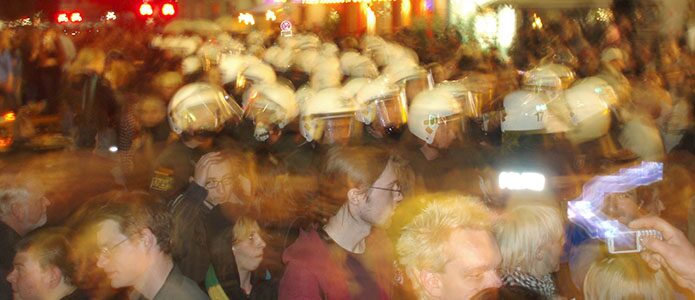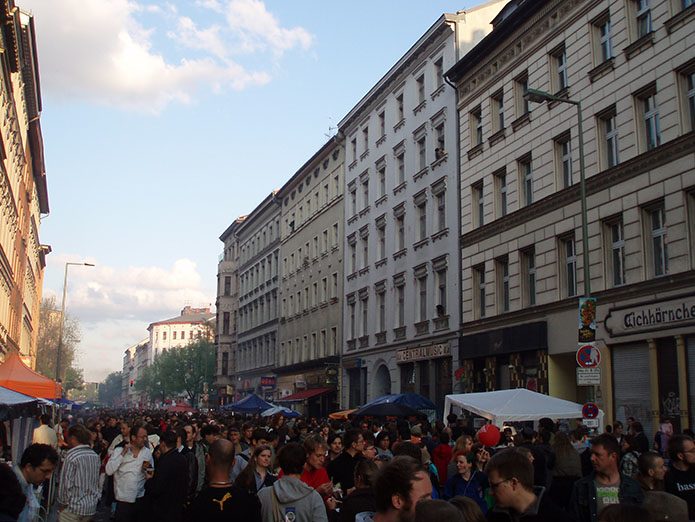Bicultural Urbanite Brianna
May Day: Protests, Parties and the end of winter

The first of May is a significant date in the German calendar. It’s a celebration of the long-awaited spring, it’s a national public holiday, a day of protest, and an opportunity to dance around a large wooden pole and drink strong beer. In Berlin, one of the main attractions is the 'Myfest' street festival in Kreuzberg. If you can handle massive crowds and love people watching, 'Myfest' is not to be missed.
By Brianna Summers
For me, May Day is primarily about breaking free from the shackles of a five-month Berlin winter. April delivers a tantalising taste of spring, but can still be pretty touch and go. One day the birds are cavorting noisily in trees studded with fresh growth and the next day it’s snowing. The Germans even have a saying for this: April, April, er macht was er will (April, April, it does whatever it wants). But by the time May rolls around, the grey funk has finally lifted, the city turns green and people stand in the streets, eyes closed, their beaming faces tracking the movement of the sun like human flowers.
Like in many places around the world, the first of May is also Labour Day in Germany. Throughout the country, trade unions mark the date by organising rallies and demonstrations that snake their way past assembled onlookers, beer trucks and sausage stands. The Tag der Arbeit has long been associated with the struggle for worker’s rights, but it wasn’t declared a national public holiday until it was co-opted by the National Socialists in 1933. The public holiday lives on, albeit with a genuinely socialist flavour.
FROM RIOTS TO STREET PARTIES
May Day has been marred by violence numerous times throughout Germany’s history and in recent decades Berlin has become a hotspot for anti-capitalist rebellion and anarchy. A major riot erupted in Kreuzberg in 1987, during which police were forced to withdraw completely from the district’s eastern neighbourhood (SO 36). While May Day is still exploited by some as an opportunity to physically express their anti-establishment attitudes, the holiday has become significantly less violent since the inauguration of the Myfest street festival. Myfest street festival in Kreuzberg in 2008. | © Brianna Summers
Myfest street festival in Kreuzberg in 2008. | © Brianna Summers
Hat’s off to the people who came up with the 'Myfest' idea. What better way to deter people from setting cars on fire and hurling rocks at cops than by throwing a massive party?
WALPURGISNACHT: THE PARTY BEFORE THE PARTY
But you won’t have to wait until the first of May to shake your tail feather or sip a ludicrously generous mojito. The night before is Walpurgisnacht, which was originally the eve of a Christian feast day, but in modern times a convenient excuse for a whole range of Tanz in den Mai parties (‘dance in the May’). These parties sometimes have a witchcraft theme, because according to German folklore, this is the night when witches gather together the highest peak of the Harz Mountains in northern Germany (I like to imagine them drinking Jagerbombs and singing along to Deichkind’s Remmidemmi).Meanwhile, in places like Bavaria, May Day seems to be a quaint and jolly affair. Which is just as well, because a large number of police from Bavaria (and around Germany) are seconded to Berlin during the public holiday. Residents erect large wooden poles known as Maibäume (May trees) for their local May Day festivities, drink strong Maibock beer and light Maifeuer bonfires to ward off witches and evil spirits. Some parts of Germany and Austria also have a tradition called Maistrich. In the night before the first of May, people draw a chalk line between the houses of two people who love each other (or may soon love each other), which ends with a love heart and the initials of the two people. It’s basically a more labour-intensive version of swiping right.
In short, May Day has something for everyone. You can protest for greater rights in the workplace, recover from your Walpurgisnacht hangover, drink beer from a plastic cup surrounded by thousands of revellers, or simply enjoy a day off to soak up the warm spring sunshine.